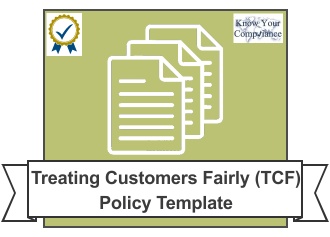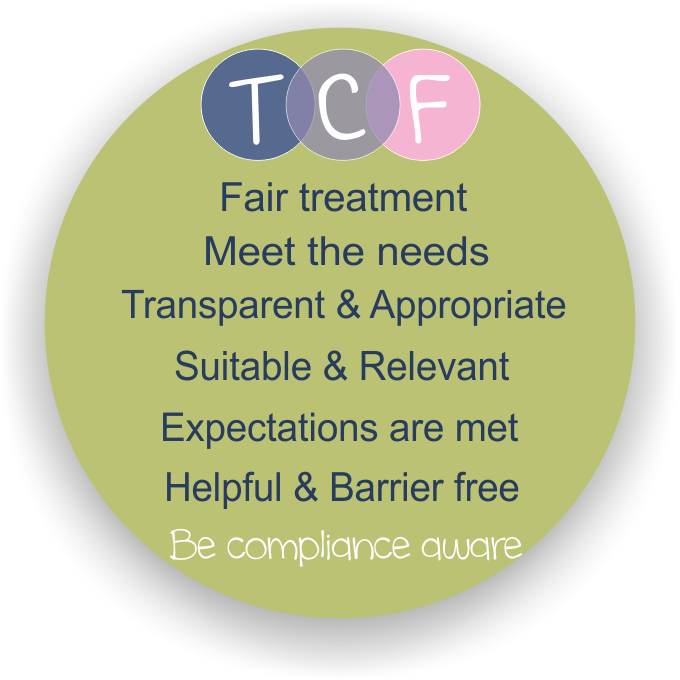-
×
 TCF Policy Template
1 × £20.00
TCF Policy Template
1 × £20.00
Subtotal: £20.00
Our article on using the 6 Outcomes to effectively implement TCF starts with the Treating Customers Fairly ethos. This was originally introduced back in July 2006 by the Financial Services Authority (FSA). The main aim was to give back confidence to consumers when dealing with the financial services industry. Pressure was put on financial and credit firms by the FSA to integrate the TCF ethos and outcomes into their business processes and culture. A much greater emphasis on those in the banking, insurance and mortgage sectors.
However, following the banking crisis in 2008/2009 and apparent lack of transparency and customer focus in the industry, the Chancellor announced in June 2010, that regulatory changes for the financial and consumer credit industries were imminent.
By April 2012, the FSA had disbanded and was replaced by the Financial Conduct Authority (FCA) and Prudential Regulation Authority (PRA). Both were tasked with bringing transparency, customer confidence and ethical trading back to the UK Financial Services industry. The FCA later expanded its governance role by replacing the Office of Fair Trading (OFT) in the regulation of consumer credit firms.

The FCA adopted the TCF outcomes and standards from the FSA, with the aim of continuing to ensure fairness, clarity and transparency in the financial and credit sectors and affording consumers using finance products and services, due consideration and increased confidence.
TCF continues to remain central to the FCA’s priorities and business plan year on year, with organisations being expected to embed and embrace the TCF culture and 6 desired outcomes. One of the FCA’s overarching Principles speaks to TCF directly: –
“A firm must pay due regard to the interests of its customers and treat them fairly.”
As part of the FCA’s TCF initiative, they expect firms to demonstrate that: –
The main crux of implementing TCF is in the 6 outcomes that are fundamental to a universal approach and developing controls and measures that are compliant and fair. It is essential that firms and their staff understand that TCF is not just about making a customer happy! A customer can be satisfied with a product or service and still have been treated unfairly according to the standards.
The 6 Treating Customers Fairly outcomes are: –
Despite far reaching and widely accessible information regarding TCF and it’s 6 outcomes, there are still firms who are not 100% sure on how to relate the outcomes to their own business objectives or that do not understand that TCF requires a universal approach that permeates every facet of the business.
Unlike many of the FCA’s rules and guidelines, TCF should impact and integrate with all processes, people (employees and customers) and systems, and has overarching outcomes as oppose to singular rules. This can sometimes lead to varying interpretations on how to implement TCF and how best to meet the needs and requirements of consumers.
Using a TCF Audit Checklist or devising your own from the regulator guidelines and handbook requirements, is a great way to start assessing your processes and seeing how integrated TCF is in your workplace. Once you have identified where the gaps are or any areas of non-compliance, you can then create an action plan with corrective actions and new controls.
Assessing gaps in any area of compliance requires a thorough understanding of what is being assessed. For example, if a company does not fully understand what TCF means to them, they will be unlikely to develop an effective checklist. It is therefore essential to understand each outcome in detail.
Whilst the outcomes themselves are clear on what objective an organisation should meet; expanding on their meaning and providing guidance on applying each outcome, is very beneficial. We have given some useful and situational guidance below on how to implement each of the outcomes.
Outcome 1: Consumers can be confident that they are dealing with firms where the fair treatment of customers is central to the corporate culture: –
 Anybody assessing your organisation and more specifically your commitment to the TCF standards, should be able to look at any area of the business, from employee knowledge and actions, through to business processes; and see how you have thought about, shared, discussed, trained on, implemented, reviewed, assessed and recorded the Treating Customers Fairly principles, ethos and outcomes.
Anybody assessing your organisation and more specifically your commitment to the TCF standards, should be able to look at any area of the business, from employee knowledge and actions, through to business processes; and see how you have thought about, shared, discussed, trained on, implemented, reviewed, assessed and recorded the Treating Customers Fairly principles, ethos and outcomes.
The key words for this outcome are transparency and evidence. The only way to instil confidence in anybody is to provide consistent and ongoing proof that you are doing exactly what you say you are doing, so simply advocating TCF or talking about what you do is not enough. You need to be able to evidence what you do whenever requested and make TCF a fundamental part of your company.
Outcome 2: Products and services marketed and sold in the retail market are designed to meet the needs of identified consumer groups and are targeted accordingly: –
This outcome focuses on defining who your products/services are made for, aimed at and beneficial to. Emphasis is placed on ‘designed to meet the needs’ which speaks strongly to not miss-selling your product/services with the overall aim of ‘just getting the sale’. Originally designed for products such as mortgages and insurance policies, this outcome now applies to the consumer credit industry as well and so must be implemented to suit all business types.
To embed this outcome into your processes, you need to define who your client/customer base is, identify their needs and ensure that your products/service meets them. For example, it may be easy to see how a mortgage or loan can be tailored and sold with a target market in mind; but relating this outcome to a sector such as debt collection agencies (DCA) is not as easy. A client who is owed money and the debtor who owes the money could both be considered as ‘customers’; each with their own needs and requirements.
Marketing and advertising materials should be clear, fair and not misleading and as the adage goes “do exactly what they say on the tin!” Assess your product or service, identify which consumer group it is aimed at, create marketing and promotional materials that promote exactly what the product/service does and aim them at the target group.
Outcome 3: Consumers are provided with clear information and are kept appropriately informed before, during and after the point of sale: –
This outcome seems quite straightforward, however there is a lot more to it than originally meets the eye! Many consumer/client relationships in the financial services and consumer credit industries can span several years and so the ‘during’ part of the outcome must be thoroughly assessed and implemented.
Checklist and audit questions of your TCF compliance with this outcome should include questions such as: –
The focus here is on all information (verbal and written) being clear, concise, free from jargon and relevant to the person who is receiving it. All forms of communication prior to, during and after the point of sale should seek to ensure that the customer knows what they are signing up to, how it benefits them or why they need it and that they have enough information to understand this.
Outcome 4: Where consumers receive advice, the advice is suitable and takes account of their circumstances: –
Not all regulated firms provide advice, however this outcome doesn’t just refer to sectors such as investment or debt management. Advice is often given on every call, from suggesting a loan type, through to guiding on what should be included in an insurance policy. If you are the expert and the customer asks you a question – you are advising them!
 It is essential that any advice given is in the best interests of the customer and NOT solely for the organisation’s best interest or targets. This outcome relies heavily on the assumption that all staff working in a role that sees them directly or indirectly giving advice to customers, are fully trained, have access to the necessary information essential to their role, have clear reporting lines and have a program of continuous professional development for their support, learning and training needs.
It is essential that any advice given is in the best interests of the customer and NOT solely for the organisation’s best interest or targets. This outcome relies heavily on the assumption that all staff working in a role that sees them directly or indirectly giving advice to customers, are fully trained, have access to the necessary information essential to their role, have clear reporting lines and have a program of continuous professional development for their support, learning and training needs.
Ensuring advice is suitable also speaks to one of the FCA’s other priority areas ‘Vulnerable Customers’. Ensuring that a customer’s circumstances are considered is essential to vulnerability identification and assessment and can only be done by human interaction. Training is therefore key to this outcome, alongside good records management to show that anyone in an advisory position is up-to-date with their product/service knowledge and has been thoroughly trained on the TCF outcomes.
Outcome 5: Consumers are provided with products that perform as firms have led them to expect, and the associated service is of an acceptable standard and as they have been led to expect: –
Simply put, you need to be delivering on what you advertise and promise with regards to your products and services. Customers should not be getting any surprises once the business relationship starts or after it ends.
This outcome requires constant quality management and auditing of the products and/or services that you offer and measuring them against your business objectives. Gaining customer feedback is pivotal to this outcome, because not all customers who are unhappy will tell you!
Surveys, questionnaires, feedback forms and customer care calls are all great ways of asking the customer how you performed, if you met their needs and if the product/service did what was expected. If you do not ask, you will not know.
Outcome 6: Consumers do not face unreasonable post-sale barriers imposed by firms to change product, switch provider, submit a claim or make a complaint: –
Outcome 6 is quite explanatory and we most people have experienced some form of post-sale barrier!
 How many times have you bought a product or service and been greeted with the most helpful, dedicated and knowledgeable salesperson alive! They are happy to stay on the phone for hours with you, just making sure that you are getting the best deal/service. But hours, days or even weeks later when you have questions or issues, no one is available or able to assist you.
How many times have you bought a product or service and been greeted with the most helpful, dedicated and knowledgeable salesperson alive! They are happy to stay on the phone for hours with you, just making sure that you are getting the best deal/service. But hours, days or even weeks later when you have questions or issues, no one is available or able to assist you.
Putting all your eggs in one basket is never a good idea and so it is with this outcome. Pumping money, resources and effort into a sales or collections team and ignoring those in complaint handling or customer service is a sure way to lose customers and your reputation. Whether you have a large after-sales team or just one person, they need the tools, resources and support to do their job effectively.
This includes ensuring effective and adequate processes and controls for complaint handling, enabling feedback, multiple way to contact you and easy access to changing products, updating details, accessing information or just asking a question.
This article provides guidance on the TCF outcomes and how they can be integrated into your organisation. There is more advice available to assist in implementing the TCF ethos and understanding the standards: –
The FCA’s Fair Treatment of Customers page provides the TCF outcomes along with some information on responsibilities and consumer feedback – https://www.fca.org.uk/firms/fair-treatment-customers
The FCA also still use the previous regulators TCF Guidance publication – https://www.fca.org.uk/publication/archive/fsa-tcf-towards.pdf
Know Your Compliance’s TCF Section provides extensive documents and packages for TCF implementation, monitoring, auditing and ready-to-use policies – https://www.knowyourcompliance.com/product-category/treating-customers-fairly
*Originally published on 8th June 2020, this article has been updated.